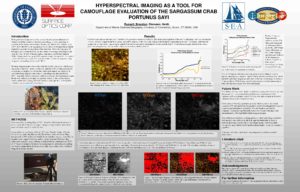Some of the most sophisticated examples of natural camouflage occur in the earth’s ocean, including the spectral camouflage or color matching demonstrated by the marine organisms surrounding Sargassum seaweed. Brandon Russell, Ph.D. student at the University of Connecticut’s Coastal Ocean Lab for Optics and Remote Sensing, applied the SOC710-VP hyperspectral camera in his study of the optics of camouflage response and effectiveness in Sargassum fauna.
Camouflage Evaluation of the Sargassum Crab

In May 2011, Russell collected spectral data of Sargassum seaweed clumps aboard the SSV Corwith Cramer in the eastern Gulf of Mexico. Floating Sargassum mats provide a critical habitat in the open ocean, which many organisms utilize for at least a portion of their life cycle. The crab Portunus sayi has a yellow/brown, mottled appearance that appears to the human eye to blend into its Sargassum habitat. Experiments involving hyperspectral imaging of adults show varied pattern and shading that changes in color in response to their background.

